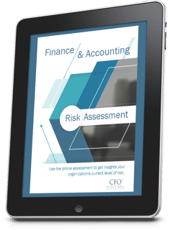
One of your most important tasks as a business leader and manager is mitigating risk. Understanding what kind of risk exists, planning for the impact of this risk, and executing continuity plans to keep the organization operational during a disruption is of paramount importance. The earlier risk can be identified, assessed, managed, and integrated into strategic planning, the better.
Typically, this burden falls on the C-Suite, but leaders at all levels should be included in the planning stage to ensure buy-in across the company. While it is easy to task an individual with overseeing risk management, ideally, it should not roll up to a single person. An emphasis on risk mitigation should be ingrained across the organization with alignment and compliance at every level. CFOs leading the charge can get their organizations on board to share the responsibility by taking a four-step approach to business continuity planning.
Identify Risk Factors
The cornerstone of risk management is identifying all possible risk scenarios. Knowing what kind of risk exists sets a foundation for business continuity planning. Risk can come from inside or outside an organization, and falls within four main areas:
- Financial Risk – The most apparent threat to a business is financial risk. Cash flow, regulatory guidelines, tax filings, fraudulent activity, lender obligations, contract stipulation, and other financial elements create dangers that all organizations need to navigate. Subsequently, these are the kinds of risks that businesses usually plan for first. However, these are, by no means, the only risks that your company may encounter.
- Operational Risk – Regardless of industry or size, a company’s operations will inherently be subject to their own risks as well. Employee turnover, manufacturing processes, materials costs, compliance requirements, and transportation logistics all provide places where risk can threaten your organization.
- Cyber Risks – Cyber risks can arise both internally and externally. Data leaks, trade secret disclosures, computer hacking, NDA breaches, and privacy infringements can pose severe risks to companies and their brands, especially in this heightened digital age. Even companies that outsource their IT functions are susceptible to cyber risk.
- Catastrophic Risk – Finally, no organization is immune to catastrophic risk. Things like natural disasters, pandemics, wars, violent acts, terrorism, embargos, and other unforeseen events can dramatically affect your business. Whether the catastrophe is a single-impact event like a fire inside a business or a widespread event like a global pandemic, these occurrences represent the worst-case scenarios for your company.
A CFO must help business leaders identify risk and understand the scope of these risks by classifying and triaging them to know how best to respond. Organizations accustomed to focusing solely on financial risk may need to be recalibrated to expand their risk horizon view.
Plan to Mitigate Risks
The goal is for a CFO to insure the business against adverse outcomes by planning for a wide variety of risk factors. Maintaining financial reserves is one of the best ways for organizations to protect themselves against not only financial risk, but also operational and catastrophic risks. As the financial head of the company, a CFO is uniquely positioned to manage this initiative. Additionally, a CFO has the skillset needed to model how the business will respond strategically to moderately or highly probable risks. Continuity planning will reduce your subsequent financial and operational impacts.
Continuously Monitor Risks
Reassess to update risk probabilities and impact scenarios periodically. While a CFO can oversee risk management, one person cannot be tasked with understanding every possible risk area when other individuals are closer to a threat. Widespread adoption of risk management enables continuous risk management, equipping your business to act swiftly when a possible risk turns into a reality.
Report and Track Risk Levels
Empower employees company-wide to identify possible risks and ensure the proper chain of command is in place to get information to analysts and key decision-makers quickly. When feedback is coming from employees on the front-line, take it seriously and track it to identify emerging trends. Where credible risk exists, weave it into your organization’s risk mitigation efforts, and give credit to the individuals or teams responsible for identifying it. Protect (and even reward) employees who report risk to encourage ongoing contribution at all levels.

Use our free financial risk assessment tool to understand where your organization stands. This assessment can help you develop a plan to manage business risk and mitigate its impact.
A financial risk assessment can make all the difference for your business. Preparing to take advantage of opportunities and eliminate potential landmines makes good business sense.
Get instant access to our free finance and accounting risk assessment here!
Originally published: 7/20/2020
Updated: 4/22/2025





